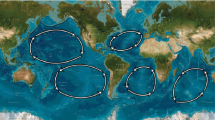Abstract
EULER is generally credited with having been the first to show that an axially symmetric rigid body, with a fractional difference between the equatorial and polar moments of inertia equal to that of the Earth, could undergo a free nutation with a period of about 300 days. That is, in a body-fixed co-ordinate system, the instantaneous axis of rotation would describe a cone about the polar axis with a 300 day period. It could have been expected that such a motion, even if present primordially, would have been damped almost completely by natural dissipative processes within the Earth. Such a motion would show itself in a periodic variation in astronomic latitude of a given site on the Earth's surface, because the rotation axis moves only slightly with respect to an inertial frame1. Despite the expectance of almost complete damping, repeated attempts were made in the nineteenth century to uncover indications of a variation in latitude with a 10 month period. None was definitely established, but in 1891 Chandler2 announced a variation with a period of 428 days, about 40 per cent larger than predicted. New-comb soon realized that the period of free nutation for the Earth would be greater than the rigid-body value, because of the fluid nature of the oceans and elastic yielding of the solid earth, and he proposed that Chandler's observations were indeed of the free nutation3. Systematic observations of latitude variations have been made since the turn of the century and clearly indicate the presence of an oscillation with this 14 month period (see Fig. 1). The amplitude of this oscillation has a maximum of about 0.3 sec of arc, that is the inclination of the instantaneous axis of rotation to the figure axis does not seem ever to exceed about 0.3 sec of arc.
Similar content being viewed by others
References
See, for example, Munk, W. H., and MacDonald, G. J. F., in The Rotation of the Earth (Cambridge Univ. Press, London, 1960).
Chandler, S. C., Astron. J., 11, 65 (1891).
Newcomb, S., Astron. J., 11, 81 (1891).
Author information
Authors and Affiliations
Rights and permissions
About this article
Cite this article
SHAPIRO, I., COLOMBO, G. Theoretical Model for the Chandler Wobble. Nature 216, 669–670 (1967). https://doi.org/10.1038/216669b0
Revised:
Issue Date:
DOI: https://doi.org/10.1038/216669b0
- Springer Nature Limited





